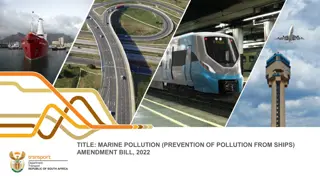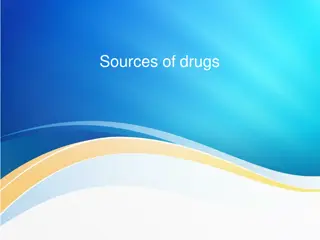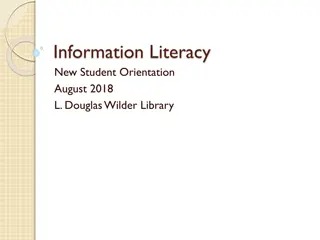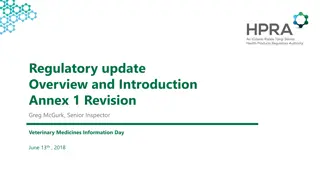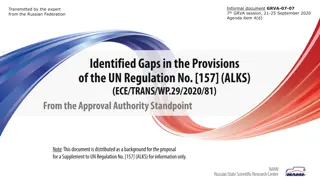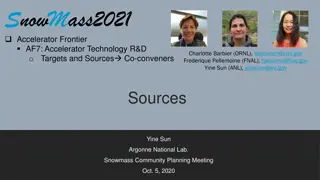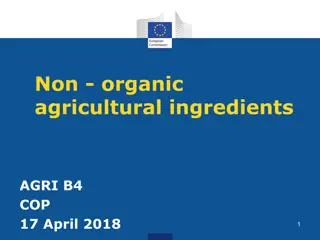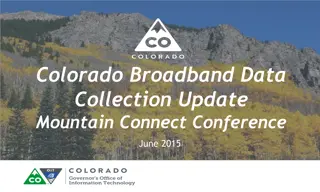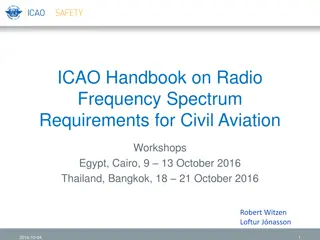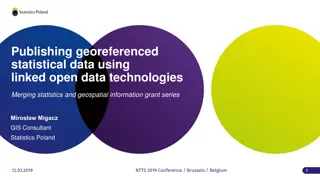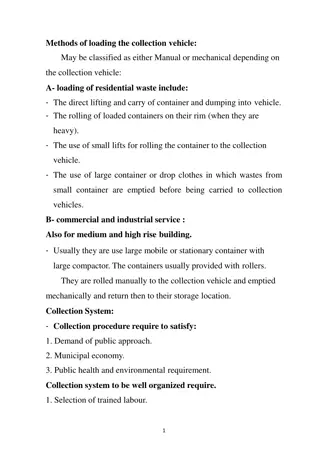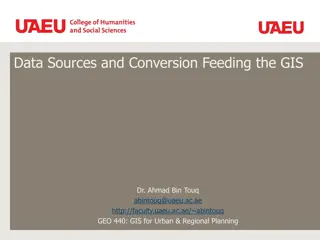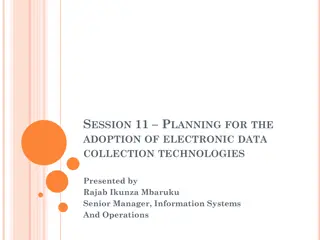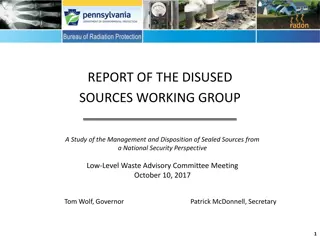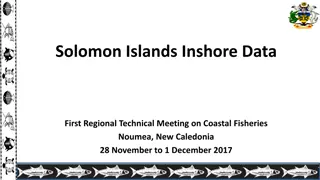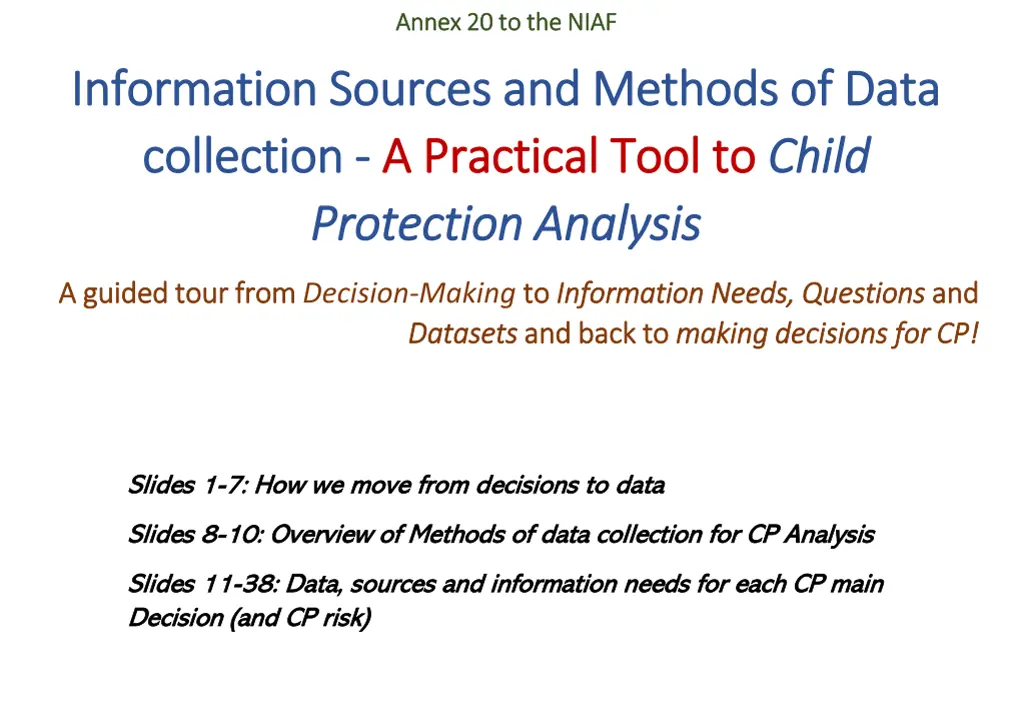
Practical Tool for Child Protection Analysis: Data Collection Methods
Explore a guided tour from decision-making to information needs and data collection methods for child protection analysis. Learn how to identify data sources and information needs for making informed decisions in child protection. Discover 4 steps to find the data needed for critical decisions in child protection.
Download Presentation

Please find below an Image/Link to download the presentation.
The content on the website is provided AS IS for your information and personal use only. It may not be sold, licensed, or shared on other websites without obtaining consent from the author. If you encounter any issues during the download, it is possible that the publisher has removed the file from their server.
You are allowed to download the files provided on this website for personal or commercial use, subject to the condition that they are used lawfully. All files are the property of their respective owners.
The content on the website is provided AS IS for your information and personal use only. It may not be sold, licensed, or shared on other websites without obtaining consent from the author.
E N D
Presentation Transcript
Annex 20 to the NIAF Annex 20 to the NIAF Information Sources and Methods of Data Information Sources and Methods of Data collection collection - - A Practical Tool to A Practical Tool to Child Protection Analysis Protection Analysis Child A guided tour from A guided tour fromDecision-Makingto to Information Needs, Questions Datasets Datasets and back to Information Needs, Questions and and back to making decisions for CP! making decisions for CP! and Slides 1 Slides 1- -7: How we move from decisions to data 7: How we move from decisions to data Slides 8 Slides 8- -10: Overview of Methods of data collection for CP Analysis 10: Overview of Methods of data collection for CP Analysis Slides 11 Slides 11- -38: Decision (and CP risk) Decision (and CP risk) 38: Data, sources and information needs for each CP main Data, sources and information needs for each CP main
Start from Use not from Questions Walking backwards Decision to be made (USE) Information Needed for Making those decisions Method of data collection Questions & Analysis Plan) 3
How do we find the data we need for the decisions we have to make- in 4 steps? 1/4 1. We start from the DECISIONS that the you have to make Decision Decision Priority Groups: What population groups will be included in the response? Child Protection priority responses: What are the CHILD PROTECTION concerns risks of children main and 4
How do we find the data we need for the decisions we have to make? 2/4 2. Then we identify what information we need to make those decisions Decision Information Need Decision Information Need Priority Groups: What population groups will be included in the response? What communities are most at risk? Who does the humanitarian community prioritize? Child Protection priority responses: What are the CHILD PROTECTION concerns risks of children Which are the main CP risks in each of the priority areas? - Dangers and Injuries main and 5
How do we find the data we need for the decisions we have to make? 3/4 3. And identify the method, source and phrasing to obtain each info Method, Source & Question Text Decision Information Need Decision Information Need Method, Source & Question Text Priority Groups: What population groups will be included in the response? What communities are most at risk? Who does the humanitarian community prioritize? Secondary Data (DTM, UNHCR, OCHA) # of people internally displaced living in camps or camp-like settings # of people internally displaced population # of refugees # of returnees % of IDPs / returnees / refugees in relation to host population Key Informants Interviews: What type of accidents are children under 18 years very likely to be injured or killed from in or around the site within the next 30 days? Focus Group Discussion: What are you most concerned about when you think of the safety of your children? Child Protection priority responses: What are the CHILD PROTECTION concerns risks of children Which are the main CP risks in each of the priority areas? - Dangers and Injuries main and 6
How do we find the data we need for the decisions we have to make? 4/4 4. And give an example of what the results will look like Method, Source & Question Text Mock-up of results Decision Information Need Decision Information Need Method, Source & Question Text Mock up of results (what to expect) Table of numbers by admin unit (e.g., District) and maps with pop density Priority Groups: What population groups will be included in the response? What communities are most at risk? Who does the humanitarian community prioritize? Secondary Data (DTM, UNHCR, OCHA) # of people internally displaced living in camps or camp-like settings # of people internally displaced population # of refugees # of returnees % of IDPs / returnees / refugees in relation to host population Key Informants Interviews: What type of accidents are children under 18 years very likely to be injured or killed from in or around the site within the next 30 days? Focus Group Discussion: What are you most concerned about when you think of the safety of your children? Child Protection priority responses: What are the CHILD PROTECTION concerns risks of children Which are the main CP risks in each of the priority areas? - Dangers and Injuries main and 7
Child Protection AoR: Information, Methodologies and Analysis - NIAF Annex Various Sources, including UNICEF, IOM, ACAPS/Pherson, Okular Analytics, UNHCR & EDAUUR (Grand Bargain) Analysis considers multiple datasets from different sources, obtained through different methods. This enables validation, spotting of errors, identification of areas of further inquiry and increased understanding. Each method of data collection provides information at a specific Unit of Measurement or Unit of Analysis Analysis refers to the organized process of transforming raw data into actionable insights, for better decision- making. Decisions on response Most forms of analysis can be described as levels, where one builds on another, each increasing the understanding of the findings and revealing progressively what the data means, what may happen next and what could / should be done about it. Six levels are commonly used for data analysis, (see image on the left). Different levels of analysis are the responsibility of different actors (as indicated in the image to the left): Decision-Makers, Subject Matter Experts (e.g., CP), Cultural /Context Experts & IM.
Different methods of data collection provide different types of information Various Sources, including UNICEF, IOM, ACAPS/Pherson, Okular Analytics, UNHCR & EDAUUR (Grand Bargain) Observation at Facilities: information on infrastructure and conditions at the time of the visit (e.g., Child Friendly Spaces or classrooms conditions, class overcrowding, visible hygiene concerns, obstacles to movement of Children with disabilities, absence of girls from school). Direct Observation in community (observers are not CP Experts), e.g., DTM MSLA: triangulate data from other methods, discover what is and is not there, spot abnormalities (e.g., many children in the streets during school hours, female latrines not segregated, UAC sleeping accommodation not separate from adults) Service Provider / Facility Community Service Provider Interviews: Collects in-depth information on challenges, risks, needs and resources of the facility and their ability to provide services (e.g., new or most common types of CP risks, dynamics and consequences for children, community/family resilience and protecting mechanisms, training needs of staff, protection concerns of specific groups of children, barriers to access to services ) Key Informants Interviews (enumerators and respondents are NOT CP Experts), e.g., DTM MSLA : Information about the impact of the crisis on the community - risks, challenges, opportunities and resilience (e.g., estimated number of children, SADD, main obstacles for children to attend schools, physical dangers for children, number of people sleeping outdoors, availability of services ) Service Provider/Facility admin data: documented statistics on facility beneficiaries and on availability of resources (e.g., attendance of girls and boys, ratio of social and case workers /children, number of cases/reported incidents, CP IMS aggregated statistics...) . Community Group discussions more in-depth understanding of awareness, obstacles to use and quality of services, as well as expectations, needs and challenges identified by the community. Household Survey: understand access to services, needs, obstacles, resources and priorities as identified by household representative (usually adult male), based on pre-defined indicators (e.g., obstacles faced by the HH to accessing services or meeting basic needs, income, level of education, reasons for not attending schools, awareness of services, problems or satisfaction with services...) from the point of view of the HH representative. Focus group discussions provide a more in-depth understanding of risks, obstacles, expectations, needs and challenges faced by specific groups (e.g., children, mothers, youth, parents, teachers, social workers interviewed separately from others), resilience tactics, as well as awareness, use and quality of protection and other services. Household AffectedGroup Essential to hear the voice of vulnerable groups, and better understand dynamics and sensitive information and for reaching specific groups directly. It allows a level of safety in sharing information that may not be discussed in front of other groups. The point of view for children, women and vulnerable groups and individuals may not be adequately capture through other methods (girls feel unsafe in the site because, we do XYZ to minimize risks of violence, we are afraid of XYZ as they can hurt us, our main priority is) For FGD with women & girls, see: https://gbvguidelines.org/wp/wp- content/uploads/2020/03/2.1-Consultations-Tip-Sheet.pdf Individual Survey: Similar to the HH survey, but identifies the specific perspective of individuals (e.g., obstacles to meeting basic needs and using services, concerns around personal safety and division of tasks/activities that may put children at higher risk ) Individual Results of Surveys result may be generalizable to the whole community or not, depending on the way the survey was designed and conducted . Note that the total numbers of children in a location is not an outcome of HH or individual surveys.
Data, sources and information needs for each Decision Once the Coordination Group has identified the information needs, the IMO can use this tool to gather existing data or even set up a data collection if needed. Each of the next slides illustrates the information needed for each of the decisions included in the NIAF, and suggests various ways and methods to obtain these specify information (Secondary Data, Key Informants Interviews, Expert Interviews, Focus Group Discussions, Facility/case management data and HH-Level surveys). This helps identify WHATinformation can be obtained through WHAT methods. Examples of phrasing of questions are also included, and should always be adapted to the context and the exercise. 8
Decision Information Need Secondary Data (from other actors/units /sectors) Capacity of authorities and national civil society Extent of need for CP activities in country Whether or not to respond (Are the Government and civil society in the country able to fully respond to the crisis or should Child Protection Coordination Group (CPCG) complement?) If the CPCG is activated the need to intervene was recognized. Just verify this is still the understanding of members of CPCG, using the existing knowledge of the Child Protection Coordination Group (CPCG) Key Informant Interviews (KI & Enumerators are not Child Protection expert) Facility level data (e.g., records) HH-Level surveys (Head of Household answers on behalf of the HH) Interviews with Experts & Service Providers (incl. staff &Partners) Mock-up of results Focus Group Discussions with homogeneous groups in the community 9
Decision Information Need Secondary Data (from other actors/units /sectors) What communities are most at risk? Who does the humanitarian community prioritize? Priority Groups: What population groups will be included in the response (IDPs, Refugees, general population, host community )? Estimated number of children in Location/Area Estimated number of boys in Location/Area Estimated number of girls in Location/Area Estimated number of Children with Disability in Location/Area Estimated number of IDP children in Location/Area Estimated number of Refugee children in Location/Area Estimated number of Migrant children in Location/Area Estimated number of children in sites/camps/camp like settings and public buildings (incl. reception centres) in Location/Area Estimated number of children in emergency shelter Location/Area Estimated number of children without any shelter (sleeping outdoors) in Location/Area Estimated number of Children SPECIFIC GROUP in Location/Area Estimated number of Children living in areas affected by natural disasters Estimated number of Children in indigenous communities Estimated number of Internally Displaced Children, displaced in the last XX months Estimated number of Children Head of Household in Location/Area Estimated number of Females Head of Household in Location/Area Estimated number of Elderly Head of Household in Location/Area Key Informant Interviews (KI & Enumerators are not Child Protection expert) Facility level data (e.g., records) HH-Level surveys (Head of Household answers on behalf of the HH) Interviews with Experts & Service Providers (incl. staff &Partners) Focus Group Discussions with homogeneous groups in the community Mock-up of results Table of numbers by admin unit (e.g., District) Maps with population density 10
Decision Information Need Secondary Data (from other actors/units /sectors) Food Insecurity level of Community/ HH Intensity of conflict/ fighting in the area Conflict intensity Presence of armed groups, gangs and forces in the area/location Presence of armed groups, gangs and forces with affiliated children Lack of safe shelter Exposure to harmful activities Large presence or increase of children's group particularly at risk Presence of Explosive Ordnance in or around location Impact of accidents in the area (proxy-only those registered by Healthcare centres) Children out of education Impact/signs of MHPSD on children Impact of Natural disaster on transportation and communication Impact of Natural disaster on Health services Impact of Natural disaster on livelihood Impact of Natural disaster on food security Impact of Natural disaster on Water, Sanitation and Hygiene Continued presence of natural disaster and consequences (e.g., areas still flooded, continued earthquakes, ) Discrimination campaigns /actions/attacks Displacement /return to secondary displacement Area of origin/transit/destination of Trafficked Children Areas with limited or no humanitarian access Birth registration Number of Children engaging in activities that may increase CP risks Prevalence of Child Labour Prevalence of Child Marriage Missing children UASC prevalence Prevalence of Child Labour What unit of analysis should we consider (governorate, district, site...)? Where do populations more impacted by the crisis (e.g., conflict, displacement, natural disaster, pandemic) live? Where do populations more at risk live/ concentrate? What of these areas have fewer child protection resources? Priority Geographical Areas: Where should CPCG focus their members response? Facility level data (e.g., records) Key Informant Interviews (KI & Enumerators are not Child Protection expert) HH-Level surveys (Head of Household answers on behalf of the HH) Interviews with Experts & Service Providers (incl. staff &Partners) Focus Group Discussions with homogeneous groups in the community Mock-up of results Maps and lists by indicator for comparison among areas and joint interpretation by CPWG members, facilitated by coordinator Existing Resources Availability Access, Quality, use and awareness of CP/GBV/Health/services in community Availability of MHPSS Services (Level 1, 2 and 3) at standard for children and parents Availability of Child Friendly Space at standard, and Women Friendly Space at standard Availability of legal Services for survivor at standard for children and parents Case management for victims of violence (referral to health, mental health, legal, and other services) Availability of other relevant services at standard for children and parents 11
Secondary Data (from other actors/units /sectors) Information Need Decision Child Protection priority responses: What are the main CHILD PROTECTION concerns and risks of children? Existing studies on prevalence of the 7 ++ main CP risks in the areas/ country, Information from the members of CPCG, who will have asked their staff on the field Which are the main CP concerns and risks in each of the priority geographical areas? Key Informant Interviews (KI & Enumerators are not Child Protection expert) Facility level data (e.g., records) HH-Level surveys (Head of Household answers on behalf of the HH) What are the main risks that under 18 years old children are exposed to in this area? What are you concerned about when you think of the safety of the children? Interviews with Experts & Service Providers (incl. staff &Partners) Focus Group Discussions with homogeneous groups in the community Mock-up of results What are the main risks children are exposed to in this area? (ask by sex, age and minority group) What are priority issues affecting under 18 years old children in this location.? Top risks as identified by community (by level of measurement, e.g., district, location ) With mothers, teachers: What are the main risks children are exposed to in this area? (ask by sex, age and minority group) What are you concerned about when you think of the safety of the children? With adolescents: what are you concerned about currently, that may be harmful to you and your friends? 12
Decision Information Need Secondary Data (from other actors/units /sectors) Child Protection priority responses: What are the main CHILD PROTECTION concerns and risks of children? What are the activities that may put children at risks? Existing studies on CP risks (links to activities exposing children to risks) Key Informant Interviews (KI & Enumerators are not Child Protection expert) Facility level data (e.g., records) HH-Level surveys (Head of Household answers on behalf of the HH) Locations/areas, times and activities where children are considered as unsafe: When and/or where do you feel your girls/boys are most unsafe? What are the main activities of the children (by child) during the day? Answer choices: fetch water, fetch firewood, look after livestock, look after siblings, look after elders, cooking, cleaning, playing with friends, study, selling items, mining, other work etc (adjust at country) Interviews with Experts & Service Providers (incl. staff &Partners) Focus Group Discussions with homogeneous groups in the community Mock-up of results What are the main activities of the girls [specify age group] during the day, if they attend school, aside of school? Answer choices: fetch water, fetch firewood, look after livestock, look after siblings, look after elders, cooking, cleaning, playing with friends, study, earn money outside etc (adjust at country) - (same question for boys) With mothers, teachers: What are the main activities of the girls /boys [specify age group] during the day? when and/or where do you feel the children are most unsafe? With adolescents: when and/or where do you and your friends feel most unsafe? May some of these girls be exposed to physical or psychological /emotional harm during these activities? - (same question for boys) 13
Decision Information Need Secondary Data (from other actors/units /sectors) Prevalence: Global school-based student health survey (GSHS):https://www.who.int/ncds/surveillance/gshs/co untry/en/ Child Protection priority responses: What are the main CHILD PROTECTION concerns and risks of children 1. Dangers and Injuries Key Informant Interviews (KI & Enumerators are not Child Protection expert) Facility level data (e.g., records) HH-Level surveys (Head of Household answers on behalf of the HH) What type of accidents are children under 18 years very likely to be injured or killed from in or around the site within the next 30 days? Accidents from physical dangers include issues with construction, site layout, weather, objects, animals. It does not include violence. (select all that apply); Are there explosive ordnance in this location or next to this site? What type of physical dangers are you mostly concerned about when you think of the health and safety of your children under 18 years? Accidents from physical dangers include issues with construction, site layout, weather, objects, animals. It does not include violence. (select all that apply) Health centre trauma cases on record - to have a sense of the impact (quantity in a set period) and trends Interviews with Experts & Service Providers (incl. staff &Partners) Focus Group Discussions with homogeneous groups in the community Mock-up of results Map of areas where Explosive Ordnance and infrastructure risks are high, medium and low Factors and actors increasing the risk of injuries Interviews on infrastructure, EO, or other reason for increased risk of injury to children with: - community service providers - Site Management Agencies - CCCM colleagues - Mine action colleagues Discussions with mothers, teachers on: Existing dangers and past incidents, Factors and actors increasing the risk of injuries Factors and actors reducing the risk of injuries Factors and actors reducing the consequences of injuries Factors and actors increasing the consequences of injuries - what increases the negative consequences of injuries on children in this area? (e.g., lack of trauma healthcare services, lack of prosthetics...) Interviews with Organizations of persons with disabilities, specialized NGOs and ICRC What type of physical dangers are you mostly concerned about when you think of the health and safety of your children under 18 years? Accidents from physical dangers include issues with construction, site layout, weather, objects, animals. It does not include violence 14
Secondary Data (from other actors/units /sectors) Cultural acceptability of physical punishment (in family, school ): - MICS - Existing researches - by country: https://endcorporalpunishment.org/regions/ - Focus on migration and displacement: https://endcorporalpunishment.org/migration-conflict-and-disaster/ Decision Information Need Child Protection priority responses: What are the main CHILD PROTECTION concerns and risks of children? 2. Physical and Emotional Maltreatment Key Informant Interviews (KI & Enumerators are not Child Protection expert) Facility level data (e.g., records) Prevalence data: - (UNICEF, WHO, National Research centres or authorities) - Estimates in NIAF Annex 11 and in UNICEF global databases (https://data.unicef.org/resources/resource-type/datasets/) - Demographic and Health Surveys (DHS) Program To download reports: https://dhsprogram.com/Publications/Publications-by- Topic.cfm (search by topic - indexed term: Domestic Violence). To find individual indicators: https://www.statcompiler.com/en/ choose indicator, complete list. To download datasets: https://dhsprogram.com/data/available-datasets.cfm (note that there is obligatory registration to download datasets, and 2 days waiting time for approval to download. The site also specifies condition of use for datasets and how to quote the sources) - Global school-based student health survey (GSHS):https://www.who.int/ncds/surveillance/gshs/country/en/ Interviews with Experts & Service Providers (incl. staff &Partners) HH-Level surveys (Head of Household answers on behalf of the HH) Interviews with experts in country (e.g., specialized NGOs, Social or Health workers, Education professionals ) or relevant authorities on: Characteristics, acceptability of physical punishment (in family, school ) and commonly used discipline methods: Factors and Actors increasing/reducing the risks of mental and physical maltreatment Factors and Actors increasing the negative consequences of mental and physical maltreatment Factors and Actors decreasing the negative consequences of mental and physical maltreatment Focus Group Discussions with homogeneous groups in the community Background (e.g. demographics, socioeconomic status, education), Gender attitudes related to violence, Perception of safety, Witnessing violence, Violence victimization, Violence perpetration, Health risk behaviors including HIV risk, Health outcomes including physical, mental, sexual and reproductive health outcomes (e.g. unintended pregnancy), Service seeking and utilization after experiencing violence: CDC, Violence Against Children Surveys - VACS Reports: https://www.cdc.gov/violenceprevention/childabuseandneglect/vacs/reports.htm l; https://www.togetherforgirls.org/violence-children-surveys/ VACS Datasets: https://www.togetherforgirls.org/request-access-vacs/ (registration to access datasets is required) Characteristics, acceptability of physical punishment (in family, school ) and commonly used discipline methods: FGD with adolescents, teachers, parents Mock-up of results Government work to prevent violence against children: https://www.who.int/teams/social-determinants-of-health/violence- prevention/global-status-report-on-violence-against-children-2020 (Part 2- Country and Area Profiles) 15
Decision Information Need Secondary Data (from other actors/units /sectors) Prevalence data: - UNICEF, WHO, National Organizations or Ministry, Estimates in NIAF Annex 11, UNICEF global databases https://data.unicef.org/resources/resource-type/datasets/ - Demographic and Health Surveys (DHS) Program To download reports: https://dhsprogram.com/Publications/Publications-by-Topic.cfm (search by topic - indexed term: Domestic Violence). To find individual indicators: https://www.statcompiler.com/en/ choose indicator, complete list. To download datasets: https://dhsprogram.com/data/available- datasets.cfm (note that there is obligatory registration to download datasets, and 2 days waiting time for approval to download. The site also specifies condition of use for datasets and how to quote the sources) Child Protection priority responses: What are the main CHILD PROTECTION concerns and risks of children? 3. Sexual Gender Based Violence Key Informant Interviews (KI & Enumerators are not Child Protection expert) Facility level data (e.g., records) Characteristics, dynamics, factors increasing/decreasing risks, trends by area and group: aggregated results from case management data (as long as persons and locations are not identifiable) Locations where risks of GBV are higher using proxy indicators: - See questions in the DTM Field Companion for GBV on status of infrastructure and other easily identifiable factors likely to increase risks of GBV: e.g., lights, locks, shelter overcrowding, ... Focus Group Discussions with homogeneous groups in the community Interviews with Experts & Service Providers (incl. staff &Partners) Background (e.g. demographics, socioeconomic status, education), Gender attitudes related to violence, Perception of safety, Witnessing violence, Violence victimization, Violence perpetration, Health risk behaviors including HIV risk, Health outcomes including physical, mental, sexual and reproductive health outcomes (e.g. unintended pregnancy), Service seeking and utilization after experiencing violence: Interviews with NGOs specialized on GBV and CP, Social workers, Health workers, Education professionals and GBV staff in the field on: Characteristics, dynamics, factors increasing/decreasing risks, trends by area and group Factors and Actors decreasing the negative consequences of incidents and violations (e.g., community mechanisms and existing services) Factors and Actors increasing the negative consequences of incidents and violations (e.g., stigmatization, deprivation of liberty, honour kilings..) Locations/areas, times and activities where specific groups (girls. Adolescents, women...) feel unsafe (or are considered as unsafe by mothers for their children CDC, Violence Against Children Surveys - VACS To download reports: https://www.cdc.gov/violenceprevention/childabuseandneglect/vacs /reports.html; https://www.togetherforgirls.org/violence-children- surveys/ To download datasets: https://www.togetherforgirls.org/request- access-vacs/ (registration to access datasets is required) Groups or categories that each group may fear HH-Level surveys (Head of Household answers on behalf of the HH) Legal Framework in country and implementation in practice: - Laws, research by Human Rights organizations, Legal experts and legal practitioners Interviews with legal experts and legal practitioners on: Legal Framework in country and implementation in practice: Legal Factors and Actors increasing the negative consequences of incidents and violations (e.g., deprivation of liberty for survivors of GBV) DO NOT USE Government work to prevent violence against children: https://www.who.int/teams/social-determinants-of-health/violence- prevention/global-status-report-on-violence-against-children-2020 (Part 2- Country and Area Profiles) 16 Mock-up of results
Decision Information Need - Child Marriage Secondary Data (from other actors/units /sectors) Prevalence data: - UNICEF, WHO, National Organizations or Ministry - Estimates in NIAF Annex 11 and in UNICEF global databases (https://data.unicef.org/resources/resource- type/datasets/) - Census data - ILO Global Estimate of Modern Slavery: https://www.ilo.org/wcmsp5/groups/public/@dgreports/@d comm/documents/publication/wcms_575479.pdf (1.3 Forced Marriage) Child Protection priority responses: What are the main CHILD PROTECTION concerns and risks of children? Facility level data (e.g., records) Prevalence data: Marriage records (where available) indicating the age of the spouses Key Informant Interviews (KI & Enumerators are not Child Protection expert) HH-Level surveys (Head of Household answers on behalf of the HH) Prevalence data: Demographic Profile, if sample and methodology produce representative results. When not, data can still provide an indication for the prevalence among the interviewed HH only. Legal Framework in country on punishment for perpetrators /safeguarding survivors and impact of implementation: - Laws, research by Human Rights organizations, legal experts and legal practitioners Perceived increase in child marriage: - Has the number of marriages of girls under 18 living in the location increased in the last [recall period]? M-1044 in DTM Field Companion - Approximately how many girls under 18 years in this location got married during the last (recall period)? M-1045 in DTM Field Companion Focus Group Discussions with homogeneous groups in the community Interviews with Experts & Service Providers (incl. staff &Partners) Mock-up of results Interviews with experts in country (e.g., specialized local organizations, Social or Health workers ), relevant service providers, CP and GBV staff on: Factors increasing /decreasing child marriage, reasons for child marriage, characteristics, dynamics in country, pre and after the crisis: Factors and Actors decreasing the negative consequences of incidents and violations (e.g., community mechanisms and existing services) Factors and Actors increasing the negative consequences of incidents and violations (e.g., stigmatization, deprivation of liberty..) Factors increasing /decreasing child marriage, reasons for child marriage, characteristics, dynamics in country, perceived increase after the crisis: Groups discussions with: mothers/women, adolescent boys, adolescent girls, grandmothers/elderly women, teachers 17
Secondary Data (from other actors/units /sectors) Decision Information Need Child Protection priority responses: What are the main CHILD PROTECTION concerns and risks of children? - Female genital mutilation Prevalence data: - UNICEF, WHO, specialized organizations - Estimates in UNICEF global databases and in UNICEF global databases (https://data.unicef.org/resources/resource- type/datasets/) http://www.cpcnetwork.org/policy-and-practice- guidance/grows/ - Estimates in NIAF Annex 11 and in UNICEF global databases (https://data.unicef.org/resources/resource- type/datasets/) - Demographic and Health Surveys (DHS) Program: To download reports: https://dhsprogram.com/Publications/Publications -by-Topic.cfm (search by topic - indexed term: Female Genital Cutting). To find individual indicators: https://www.statcompiler.com/en/ choose indicator, complete list. To download datasets: https://dhsprogram.com/data/available- datasets.cfm (note that there is obligatory registration to download datasets, and 2 days waiting time for approval to download. The site also specifies condition of use for datasets and how to quote the sources) Key Informant Interviews (KI & Enumerators are not Child Protection expert) Facility level data (e.g., records) Proxy to indicate health impact: Healthcare records (where available) indicating health consequences of FGM/cutting Focus Group Discussions with homogeneous groups in the community Interviews with Experts & Service Providers (incl. staff &Partners) Perceptions and changes in perception, dynamics, motivations, health and social impact: Discussions with women, adolescents, older women and girls Interviews with specialized NGOs, Social or Health workers, anthropologists on: Factors increasing /decreasing FGM/cutting, reasons, characteristics, dynamics, categories doing the procedures, locations and health consequences, role of family members, women and men in country, pre and after the crisis Factors and Actors decreasing the negative consequences of incidents and violations (e.g., community mechanisms and existing services) Factors and Actors increasing the negative consequences of incidents and violations (e.g., stigmatization, loss of opportunities..) HH-Level surveys Mock-up of results (Head of Household answers on behalf of the HH) 18
HH-Level surveys Information Need Decision (Head of Household answers on behalf of the HH) Have you seen signs of distress such as changes in behaviours in family members below the age of 18 since the conflict/crisis began / since you had to leave your home? Withdrawn from family and friends , Angry or aggressive outbursts, Changes in appetite or eating habits, Headaches, New or recurrent bedwetting, Nightmares or sleep disturbances, Upset stomach or vague stomach pain, New or recurring fears (fear of the dark, fear of being alone, fear of strangers), Clinging, unwilling to let you out of sight, Excessive crying Going back to behaviours present when a younger age, Startled easily, Substance use/abuse Child Protection priority responses: What are the main CHILD PROTECTION concerns and risks of children? 4. MHPS Distress Secondary Data (other actors) Prevalence data: - UNICEF, WHO, National Organizations or Ministry - Estimates in NIAF Annex 11 - Global school-based student health survey (GSHS):https://www.who.int/ncd s/surveillance/gshs/country/en/ Key Informant Interviews (KI & Enumerators are not Child Protection expert) Locations where community perceived an increase in behaviours that may be linked to worsening Mental Health and Psychological Distress: Is a large number of persons in your community currently so upset to be unable to conduct usual daily activities (for example getting out of bed, ability to work, to take care of family )? Locally available response to increased MHPS distress: Who provides support to the individuals who are unable to conduct daily activities due to mental health issues? (adjust DTM Field Companion question M0085 to be child-specific) Facility level data (e.g., records) Information on types of mental health issues received by service providers (this is not providing prevalence data, as many likely will not be reported) Focus Group Discussions with homogeneous groups in the community Discussions with women, elderly women, adolescents and men on: Cultural understanding of family in the context: who the caretakers commonly are and what is a typical family Sources of resilience: what makes children and parents cope (without AoR intervention) e.g., school, activities, family, spiritual institutions Children school attendance. Partners attending church/mosque/temple or other, status of social structures (intact or interrupted/fractured) Types of stress children and parents are exposed to Type of stigma around emotional distress and Mental Health How do families and communities support persons who are so upset to be unable to conduct usual daily activities or have other MHPSS issue Traditional healing methods after trauma in the community/group, e.g., ritual bathing, cleaning of specific body parts... Interviews with Experts & Service Providers (incl. staff &Partners) Interviews with Social workers, Service Providers and Teachers on: Cultural understanding of family in the context: who are the caretakers? what is a typical family? Sources of resilience: what makes children and parents cope (without AoR intervention)? e.g., school, activities, family, spiritual institutions? Do children go to school? Do partners go to church/mosque/temple? Are the social structures intact or interrupted/fractured? Types of stress children and parents are exposed to What type of stigma is there in this context around emotional distress and Mental Health? What are the traditional healing methods after trauma? e.g., ritual bathing, cleaning of specific body parts... Existing formal and informal 1)mental health and 2)psychosocial support services (humanitarian, development, governmental, NGOs, community..) Interviews with Mental Health Experts, service providers on: Is there a process to identify the appropriate solution (e.g., psychological, psychiatric support) that is in accordance with international standards and practices? (e.g., distinction between psychologist and psychiatrist, over /under availability of one type of support over the other) What are the common types of psychological problems? (not symptoms) Depression? PTS? What are common mental health problems in this context before and after the crisis (epilepsy, behavioural problems, substance abuse...) Existence and location of specialized mental health services and psychiatric institution (NGOs, private, Government...) Availability and access to psychiatric medications (where to buy them, affordability, over the counter...) Existing formal and informal 1)mental health and 2)psychosocial support services (humanitarian, development, governmental, NGOs, community..) 19 Mock-up of results
Focus Group Discussions with homogeneous groups in the community Decision Information Need Child Protection priority responses: What are the main CHILD PROTECTION concerns and risks of children? 5. Children Associated to Armed Forces and Armed Groups (CAAFAG) Do not ask directly about CAAFAG, as it may put people at risk Ask parents, teachers, grandparents about their concerns for children's safety. If the answers highlight recruitment by armed entities, and if safe to discuss, facilitator can explore dynamics of recruitment, reasons, when it happens, what groups are recruiting/kidnapping, what age/gender/group of children are usually taken, what activities are children used for, What are they given by the entities (e.g., food, money, recognition), Do children ever go back to their community? what happens in that case? Secondary Data (from other actors/units /sectors) Key Informant Interviews (KI & Enumerators are not Child Protection expert) Available, aggregated, MRM data (in MRM countries) When MRM data and reports cannot be shared for security, safety and other reasons, an interview with MRM focal point or team is very useful to understand: Dynamics of recruitment, Whether it is voluntary or not, How and when it happens, What entities are recruiting/kidnapping, What age/gender/group of children are usually taken/recruited, What activities are children used for What are they given by the entities (e.g., food, money, recognition, ...), Do children ever go back to their community? what happens in that case? What is the attitude of families/communities once children are released and go back to the community (or can they?); Factors and Actors increasing /reducing the risk; Factors and Actors increasing/reducing the negative consequences of incidents and violations (e.g., community mechanisms and existing services, stigmatization, loss of opportunities.) Do not ask directly about CAAFAG, as it may put people at risk As a proxy, you may be able to use "Children missing from the community e.g., "Approximately how many children under 18 years have gone missing from your community during the last [recall period]?" M1040 in DTM Field Companion for CP. However, note that: - the number cannot be exact, but it gives a sense of the scale of the problem. - there are many reasons why children may be missing, so a follow up question is needed to understand if it is related with CAAFAG . - recruitment may also be voluntary, and therefore such children would not be considered as "missing" by Key informants. An accurate risk assessment should be conducted before such Group Discussions, and other sources and methods will have to be used before FGD is implemented. It is a decision to be taken with extreme caution: - Recruitment may be voluntary and may be a way of coping with lack of access to basic goods and services. - Sometimes communities /children may have ideological affinity to armed entities. - Sometimes discussing CAAFAG in public may result in harm to the community, the children and the enumerators/facilitators or other organization staff Interviews with Experts & Service Providers (incl. staff &Partners) - Interviews with MRM focal point or Team - Interviews with activists, service providers, teachers on issues below (Do not ask directly about CAAFAG, as it may put people at risk. If the issue is highlighted by the expert in the interview, you can inquire further, but carefully see note to FGD) Admin level data (e.g., records) MRM and demobilization aggregated data (where available) Dynamics of recruitment, Whether it is voluntary or not, How and when it happens, What entities are recruiting/ kidnapping, What age/gender/group of children are usually taken/recruited . What activities are children used for, What are they given by the entities (e.g., food, money, recognition, ...), Do children ever go back to their community? what happens in that case? What is the attitude of families/communities once children are reliesed and go back to the community (or can they?) What services are in place to prevent risk and to support CAAFAG during their involvement with armed entities, and after. Factors and Actors increasing /reducing the risk; Factors and Actors increasing/reducing the negative consequences of incidents and violations (e.g., community mechanisms and existing services, stigmatization, loss of opportunities.) HH-Level surveys (Head of Household answers on behalf of the HH) DO NOT USE Mock-up of results 20
Secondary Data (from other actors/units /sectors) Estimated Prevalence data: UNICEF global databases (https://data.unicef.org/resources/resource- type/datasets/) Decision Information Need 6. Child Labour Child Protection priority responses: What are the main CHILD PROTECTION concerns and risks of children? Facility level data (e.g., records) Existing research on: - Common types of CL, children common tasks, and at-risk groups in the country before/ during the crisis - Existing economic sectors using child labour Focus Group Discussions with homogeneous groups in the community Key Informant Interviews (KI & Enumerators are not Child Protection expert) - ILO Global Estimate of Modern Slavery: https://www.ilo.org/wcmsp5/groups/public/@dgre ports/@dcomm/documents/publication/wcms_575 479.pdf 1.2 Forced Labour FGD or Community Group Discussions with parents, teachers, grandparents and others on: - Activities girls and boys carry out during the day - Reasons for lack of school attendance of girls and of boys - For children who work, what type of work do they do? - What dangers are they exposed to? Do they come back home after work or stay elsewhere? where? Do they go to school before/after work? - Who decides if a child should work or go to school? - What is the reason that pushes a child to work/or the family to send him to work? - What would be useful to families /children and limit their need to work? Would they go to school in that case? HH-Level surveys (Head of Household answers on behalf of the HH) Prevalence: HH interviews Demographic Profile -asks about family members working, not necessary equal to child labour. However, it can be used together with other info . - What are the main activities of the child during the day? Fetch water, Fetch firewood, Look after livestock, Look after siblings, Look after elders, Cooking, cleaning, Playing with friends, Study, Transporting people or goods, Garbage collection, Casual labour (waiter or porter), working with machinery or lifting, Street vending , Domestic labour, other work in the house, other work outside the house, other - Has the child attended school in the last 30 days. Yes/No and with context information, e.g., schools are accessible in the community. Interviews with Experts & Service Providers (incl. staff &Partners) Interviews with specialized organizations, activists and Social workers in the field on: - Types of work involving children and their tasks, before and after the crisis - Dangers children are exposed to during their work - Times of day, periods of the year whe children are working, and their impact on their access to education - Groups of children more at risk of child labour - Factors that increse / decrease risk of CL after the crisis (by group at risk) - Actors that increse / decrease risk of CL after the crisis (by group at-risk) - Family/community mechanisms to protect children from the risk of CL - Family/community mechanisms to limit negative consequences on children already involved in CL - Factors and Actors decreasing the negative consequences of incidents and violations (e.g., community mechanisms and existing services) - Factors and Actors increasing the negative consequences of incidents and violations (e.g., stigmatization, loss of opportunities..) Mock-up of results 21
Decision Secondary Data (from other actors/units /sectors) Information Need - Trafficking Child Protection priority responses: What are the main CHILD PROTECTION concerns and risks of children? Prevalence, Sectors of the economy linked to trafficking, trafficking routes, means, purposes of trafficking, acts of recruitment and captivity/bondage, groups more at risk per type of trafficking, dangers on the route or during the work, links with criminal groups and perceived interests and practices by authorities. Facility level data (e.g., records) Service providers may provide aggregated data to inform on means, purposes of trafficking, acts of recruitment and captivity/bondage, dangers on the route or during the work Key Informant Interviews (KI & Enumerators are not Child Protection expert) Direct questions in KI interviews on the issue of Trafficking must be avoided, as the risk of doing harm is extremely high. Proxy indicators that may alert CT experts in displacement situations may include: offers of employment, arranged marriage, education, travel elsewhere to specific groups (e.g., boys, girls...) - DTM Field Companion M0280/287 - US Dept of State, Trafficking in Persons Report by country: https://www.state.gov/trafficking-in- persons-report/ - Country Narratives - UNODC, Global Report on Trafficking in Persons, Chapter II Regional Overviews: https://www.unodc.org/unodc/data-and- analysis/glotip.html - ILO Global Estimate of Modern Slavery: https://www.ilo.org/wcmsp5/groups/public/@dgrepo rts/@dcomm/documents/publication/wcms_575479. pdf - IOM MPA CT reports (e.g., https://migrationdataportal.org/themes/human- trafficking) - Reports of Human Rights organizations, Anti- Trafficking actors and alliances (e.g., https://gaatw.org/ & https://www.ctdatacollaborative.org/) - Report and research on trafficking and survivors by grassroots and religious organizations working in countries of destination. - Proxy indicators from GBV and Protection - For more info, please see; (see draft IOM Counter-Trafficking in Emergencies: Information Management Guide) Interviews with Experts & Service Providers (incl. staff &Partners) Interviews with Anti-Trafficking actors: - in country of destination, as they can more safely provide information on the whole route. - in country of origin and transfer may have specific details on parts of the route and real time information on recent changes. Example of actors: IOM MPA CT teams in the field, relevant law enforcement agency, Specialized organizations helping survivors of trafficking, including faith-based support groups in countries of destination (e.g., Europe, South Africa, US/Canada, Gulf countries...) Have boys/girls in this location been offered work, or have their families been approached with such offers for their children - outside the camp or country? Have boys/girls or their families in this location been approached about education opportunities outside of the camp or country? Sectors of the economy linked to trafficking, trafficking routes, means, purposes of trafficking, acts of recruitment and captivity/bondage, groups more at risk per type of trafficking, dangers on the route or during the work, links with criminal groups and perceived interests and practices by authorities, - Factors and Actors increasing/decreasing the risk, - Factors and Actors decreasing the negative consequences of incidents and violations (e.g., community mechanisms and existing services), - Factors and Actors increasing the negative consequences of incidents and violations (e.g., stigmatization, loss of opportunities..) Have children in this location been approached with an offer to arrange a marriage, or have their families been approached with such offers for their children - outside of the camp or country? Were there any other travel opportunities being offered to people in this location? where to? HH-Level surveys Focus Group Discussions with homogeneous groups in the community DO NOT USE (Head of Household answers on behalf of the HH) DO NOT USE Mock-up of results 22
Secondary Data (from other actors/units /sectors) Prevalence data: UNICEF, authorities , specialized organization /NGOs by area Decision Information Need Child Protection priority responses: What are the main CHILD PROTECTION concerns and risks of children? 7. UASC Legal Framework and bottlenecks to prevent and respond to family separation: Existing laws, research Facility level data (e.g., records) Number of UASC in institutions (from those institutions records) Number of cases reported to service providers to use as a proxy, not as prevalence data, as the actual number of family separation will likely be much higher Key Informant Interviews (KI & Enumerators are not Child Protection expert) Mapping of existing service providers to respond to Family Separation: UNICEF, authorities, specialized organization/NGOs by area Estimated number of Unaccompanied Children at each location: - Approximately how many children under 18 years in this location living with no mother, no father or any other adult family members? (already in DTM Field Companion M-1042) Estimated number of Separated Children at each location: How many minors under 18 years are not living with their parents, however are living with other relatives? DTM Field Companion - M0513) Estimated number of Missing Children at each location: Approximately how many children under 18 years have gone missing from your community during the last [recall period]? (already in DTM Field Companion M-1040) Mapping of institutions hosting UASC: UNICEF, authorities, specialized organization/NGOs by area HH-Level surveys Focus Group Discussions with homogeneous groups in the community (Head of Household answers on behalf of the HH) Interviews with families, women, adolescents on: Separated Children: demographic profile of children living under the same roof and relationship with Head of Household (adapt): a)son/daughter, b)other relative (cousin, nephew ), c) from outside the family - Characteristics and dynamics of family separation in their community - perceptions of what factors increase/decrease risks of separation - Actors increasing and decreasing risk of family separation (who they fear the most) - Groups (gender, age, activities, areas) more at risk of separation - What families would do in case of separation Mock-up of results Interviews with Experts & Service Providers (incl. staff &Partners) Interviews with ICRC, Red cross/Crescent RFL experts and case managers, and other service providers, Social workers in the field on: - Characteristics and dynamics of family separation (pre and post crisis) - Factors increasing/decreasing risks of separation - Actors increasing and decreasing risk of family separation - Groups (gender, age, activities, areas) more at rick of separation - Main actors responding to family separation and existing services - Actors and services decreasing negative consequences of separation) - Institutions for UASC - Standard operating procedures for case management and info exchange - Legal Framework and bottlenecks to prevent and respond to family separation 23
Decision Mock-up of results Information Need Defining the aim and strategy of the response: Considering all the above, what do we want to change in each priority area? What are the main CP issues that CPCG is aiming at changing in this context and with current /forecast limitations? Decisions are taken by CPCG at the end of the joint strategic analysis session based on: - CP Minimum Standards, - Analysis of previous information and - existing knowledge of the Child Protection Coordination Group (CPCG) Roles and Responsibility for each Level of Analysis Joint Analysis Session In the joint analysis session, IMO presents descriptive analysis of all information collected as per previous pages. Coordination Group members provide subject-matter (Child Protection) and context/cultural expertise relative to the country or geographical areas of the emergency. They jointly identify correlations and explanations, interpret the information, anticipate what would happen without CPCG response and identify what the group will try to change with their response. 24
Decision Information Need Secondary Data (from other actors/units /sectors) Population Targeted: How many people should the response target? Will the response target caregivers/adults? How many children are in need of support to prevent risk or minimize impact of violence (CiN)? How many adults should we target to support children in need? How many can we reach, considering the current and likely access limitations? Where are they? Access limitations: number, type and location of attacks, security incidents (e.g., UNDSS, OCHA, Ministries, Media) children and Key Informant Interviews (KI & Enumerators are not Child Protection expert) Target children are calculated considering: CiN in priority areas, humanitarian access limitations, and CPCG capacity to respond/complement local actors' response.. HH-Level surveys (Head of Household answers on behalf of the HH) Access to each locations in priority areas Is the location physically accessible? Is it safe and secure to access the location? (already in DTM MSLA Field Companion: M109 - M-110) Target adults are calculated on the basis of how many adults /care-giver/ adults with CP responsibilities need to be supported to be able to support the target Children Facility level data (e.g., records) Focus Group Discussions with homogeneous groups in the community Interviews with Experts & Service Providers (incl. staff &Partners) Mock-up of results Children in Need per admin area, Target Children and Target Adults, access maps and tables Areas with limited access and type of access that is limited: Security, context and safety staff from NGOs and NGO networks and safety NGOs (e.g., INSO) 25
Decision Information Need Secondary Data (from other actors/units /sectors) In the priority geographical areas, How are some groups (e.g., minorities) treated differently and/or discriminated against? What groups have a limited access to basic goods and services? Where in the priority areas are these groups living (urban/centre/periphery )? What groups of children are disproportionally impacted by violence? What groups are more exposed to CP risks? What groups have fewer resources to manage the consequences of violence against children? (services by area and by group accessing them) What children groups have limited access to education? What children s sub-groups should be prioritized? Who is more at risk or more impacted by incidents or without sufficient support (children in institutions, children going through case management but pending solutions)? - Existing academic research, specialized NGOs and Civil Society research - Anthropological and sociology studies on minorities and specific groups - National Bureau of statistics: on where in the area are disadvantage groups living in (urban/centre/periphery ) - 3/4/5W: on service availability by type and area Key Informant Interviews (KI & Enumerators are not Child Protection expert) - What demographic groups face the most safety and protection issues for displaced children? (in DTM Field Companion M1052) - Who faces risks/obstacles obtaining assistance/ accessing services? (in IOM DTM Field Companion M0203) - Why some children cannot or do not access any services? Answer choices: they don t know that services are available, parents do not allow them, they are busy with HH chores. (Annex 12 to NIAF) HH-Level surveys (Head of Household answers on behalf of the HH) Facility level data (e.g., records) For indication on increased exposure to CP risks of specific groups: Analyse data collected on CP risks, using group as a variable (this is not always possible: it can be done only if it is appropriate to collect info on the group (e.g., minority the HH belongs to) Risks, impact on specific groups and ability to report incidents Case management data: aggregated & anonymized summary of typologies of cases analysed by group of children Interviews with Experts & Service Providers (incl. staff &Partners) Focus Group Discussions with homogeneous groups in the community Mock-up of results Interviews with Social workers, Child Protection experts, service providers, education professionals, Organizations of People with disabilities, field staff of CPWG members on: Discriminated groups, groups whose culture /traditions increase specific CP risks, Limitations to access to services, Access to education, Impact of violence on specific groups, Service availability and quality by area - Annex 12 to NIAF: Who are not accessing services? (adolescent boys, adolescent girls, girls, boys, children with disabilities, unaccompanied children etc. ) In the priority geographical areas, conduct Focus Group discussions with minorities, women, older people, adolescents and PwD on: What groups have a limited access to basic goods and services? Where in the priority areas are these groups living (urban/centre/periphery )? What groups of children are disproportionally impacted by violence? What groups are more exposed to CP risks? What groups have fewer resources to manage the consequences of violence against children? (services by area and by group accessing them) What children groups have limited access to education? List of groups (minorities, gender, age, areas, nationalities, language) more exposed to CP risks and/or with less access to resources. These can be used also by other sectors when mainstreaming protection in their response. 26
Decision Information Need How to intervene to prevent each one of the priority CP risk? (Maltreatment, SGBV, Mental Health and Psychosocial Distress, Child Labour, Trafficking, Recruitment, FGM/cutting, Family Separation) - What community/family mechanisms are already utilized to decrease likelihood of each CP risk? - What services are available in priority areas to decrease exposure to each CP risk? [for these, use the data obtained above, under each risks: - Factors and Actors decreasing each risks (e.g., community mechanisms and existing services) - What interventions have been successful in the country/other context to decrease exposure to each CP risk? Can they be replicated in the current context? [for these, use the experience and knowledge of colleagues in the CPCG, including relevant local implementing partners, governmental service providers and CP grassroots organizations and national NGOs)] Secondary Data (from other actors/units /sectors) Key Informant Interviews (KI & Enumerators are not Child Protection expert) Facility level data (e.g., records) HH-Level surveys (Head of Household answers on behalf of the HH) Awareness: What services are available for children in this area? Answer choices: list of child protection services in a plain language (ask CP actors to adjust to the available services based on CP 4Ws and referral pathways) Barriers: What makes it difficult to access these services? Physical, Financial, Quality, Interviews with Experts & Service Providers (incl. staff &Partners) Focus Group Discussions with homogeneous groups in the community What opportunities do children have in the community to remain safe from risks? Who is providing these services? What groups of children use these opportunities? Which groups of children do not usually use these opportunities? Why not? What are the most effective of these opportunities? What makes them so effective in preventing these risk/risks? What opportunities do children have in the community to remain safe from risks? Who is providing these services? What groups of children use these opportunities? Which groups of children do not usually use these opportunities? Why not? What are the most effective of these opportunities? What makes them so effective in preventing these risk/risks? Mock-up of results 27
Decision Information Need - What community/family mechanisms are already utilized to reduce negative consequences for each violation? - What services are available in priority areas to reduce negative consequences of each violation? How to intervene to provide services for survivors of each one of the priority CP violation? (Dangers & Injuries, Maltreatment, SGBV, Mental Health and Psychosocial Distress, Child Labour, Trafficking, Recruitment, FGM/cutting, Family Separation) [for these, use the data obtained above, under each risks: - Factors and Actors decreasing the negative consequences of incidents and violations (e.g., community mechanisms and existing services)] - What interventions have been successful in the country and can be replicated in the current context? [for these, use the experience and knowledge of colleagues in the CPCG, including relevant local implementing partners, governmental service providers and CP grassroots organizations and national NGOs] Secondary Data (from other actors/units /sectors) Key Informant Interviews (KI & Enumerators are not Child Protection expert) Facility level data (e.g., records) HH-Level surveys Focus Group Discussions with homogeneous groups in the community What services are available for children in this area? Answer choices: list of child protection services in a plain language (ask CP actors to adjust to the available services based on CP 4Ws and referral pathways) What services do you think children can access? Answer choices: same as the first questions Where do girls /boys normally seek support from first when they have problems? Answer choices: mother, father, peers, teachers, community leaders, religious leaders, child protection workers, Medical Clinic; Legal support; Women's organization; Family members; They would not seek any help; (adjust to what is useful for response planning) Who provides care for children when children face problems? Answer choices: mother, father, other members of family, community leaders, CP workers etc ; (adjust to what is useful for response planning) Interviews with Experts & Service Providers (incl. staff &Partners) What services are available for children in this area? Answer choices: list of specialised child protection services (ask CP actors to adjust to the available services based on CP 4Ws and referral pathways) What services do you think children can access? Answer choices: same as the first questions Where do girls /boys normally seek support from first when they have problems? Answer choices: mother, father, peers, teachers, community leaders, religious leaders, child protection workers, Medical Clinic; Legal support; Women's organization; Family members; They would not seek any help; (adjust to what is useful for response planning) Who provides care for children when children face problems? Answer choices: mother, father, other members of family, community leaders, CP workers etc ; (adjust to what is useful for response planning) (Head of Household answers on behalf of the HH) Awareness: What services are available for children in this area? Answer choices: list of child protection services in a plain language (ask CP actors to adjust to the available services based on CP 4Ws and referral pathways) Mock-up of results 28
Decision Information Need Secondary Data (from other actors/units /sectors) Existing reports by UNICEF or NGOs or other actors on barriers and obstacles to access of all and specific groups of children: Food and age appropriate nutrition , Healthcare & Vaccinations, Clean water, Hygiene, Safe sanitation, Safe shelter, Appropriate Education, Safe living environment (e.g., infrastructure), Age appropriate developmental activities (e.g., social, sports, ...) How to intervene to enhance delivery of basic goods and services for children most at risk? (mainstreaming support to other sectoral programming) What are the barriers that children face in accessing basic goods? What are the barriers that children face in accessing basic services? What groups of children face additional barriers? Key Informant Interviews (KI & Enumerators are not Child Protection expert) Facility level data (e.g., records) Barriers to access of all population to basic goods and services (See DTM Field Companion for CP - Mainstreaming, e.g., What is preventing most people from accessing healthcare services? M0095; Top 3 most reported problems in obtaining assistance/ accessing services M0202) HH-Level surveys (Head of Household answers on behalf of the HH) Access of HH to basic goods and services (filtered by HH including children, when possible filtered by other sub-group) Obstacles to access (filtered by HH including children, when possible filtered by other sub- group) When sample is not sufficient to be representative, use as an indication Barriers faced by specific groups (incl. children/boys and girls): (See DTM Field Companion for CP - Mainstreaming, e.g., Who faces additional obstacles accessing healthcare services? M0096: If specific groups face additional obstacles in accessing healthcare services, what are those obstacles? M0097; Who faces risks/obstacles obtaining assistance/ accessing services? M0203); Are vulnerable households, including children without parents or relatives, given priority access to distributions M0206) Interviews with Experts & Service Providers (incl. staff &Partners) Mock-up of results Focus Group Discussions with homogeneous groups in the community Specific groups of children and families who face obstacles in accessing basic goods and services Types of obstacles faced 29
Decision Information Need Secondary Data (from other actors/units /sectors) Existing activities: use information from CP 3/4/5W and other types of CP activities mapping - Current and expected Impact of new factors that force the CP to change modalities from previous HNO / previous response Where and what activities can continue, must be adapted or should be suspended - In which ones of the priority areas is the impact of these new factors likely to be greatest? [use info obtained for pages 10-23 and page 26] - What activities will likely be impacted? [consider info obtained for pages 27-29, together with 3/4/5W and other types of CP activities mapping] - What changes an/or alternative modalities can work in the changed context? [in light of activities identified for pages 27-29] Key Informant Interviews (KI & Enumerators are not Child Protection expert) Facility level data (e.g., records) HH-Level surveys (Head of Household answers on behalf of the HH) Interviews with Experts & Service Providers (incl. staff &Partners) Mock-up of results Focus Group Discussions with homogeneous groups in the community 30
Decision Information Need Secondary Data (from other actors/units /sectors) Existing geographical areas where actors are working use information from CP 3/4/5W and other types of CP activities mapping -What existing community-based risk prevention mechanisms and measures that are mitigating the impact of incidents on children and families can the CPCG strengthen and how? [use info obtained for pages 14-23] -Who implements these mechanisms and measures? [use info obtained for pages 14-23] - Where in the priority geographical areas are these actors? - Where are the geographical gaps? -What are the gaps in skillsets that CPWG should fill? Which local actors can CPCG support and how? Local actors gaps in skillsets: - Existing knowledge of CPCG members and their partners who worked with such actors Facility level data (e.g., records) Key Informant Interviews (KI & Enumerators are not Child Protection expert) HH-Level surveys (Head of Household answers on behalf of the HH) Number of staff and training/education level of staff of CP actors/service providers: existing HR records (within privacy limitation rules) Interviews with Experts & Service Providers (incl. staff &Partners) Mock-up of results Focus Group Discussions with homogeneous groups in the community Interviews with local actors to identify: - gaps in their skillsets (self reported or guided inquiry) Interviews with CP experts (also in CPCG members and their partners) who worked with such actors to identify: - gaps in their skillsets, as perceived by other experts 31
Decision Information Need Secondary Data (from other actors/units /sectors) -Which actors in the CPCG have the appropriate skillsets and field presence that allow them to fill the identified gaps in response/support existing actors, in the priority geographical areas? [ask members of the CPCG and their partners] - Can any of them cover additional geographical areas where gaps were identified? [ask members of the CPCG and their partners] The actors in the CPCG that will respond (with a strong focus on local partners) Key Informant Interviews (KI & Enumerators are not Child Protection expert) Facility level data (e.g., records) HH-Level surveys (Head of Household answers on behalf of the HH) Interviews with Experts & Service Providers (incl. staff &Partners) Mock-up of results Focus Group Discussions with homogeneous groups in the community 32
Decision Information Need Secondary Data (from other actors/units /sectors) The amount of money, time and human resources that will be allocated for the CPCG response - How much money is needed to support existing actors and fill gaps? [ask members of the CPCG and their partners] Key Informant Interviews (KI & Enumerators are not Child Protection expert) Facility level data (e.g., records) HH-Level surveys (Head of Household answers on behalf of the HH) Interviews with Experts & Service Providers (incl. staff &Partners) Mock-up of results Focus Group Discussions with homogeneous groups in the community 33
Decision Information Need Secondary Data (from other actors/units /sectors) -What are the key information that allow CPCG to identify alerts and understand new needs? [ask members of the CPCG and their partners] Changing the response on the basis of new evidence, also outside the current funding cycle Review data from CPCG and other relevant actors and identify those data and information that can be accessed regularly and indicate a high likelihood of a significant change. Systematize sharing of such data with CPCG and thresholds to set up field visits for verification Key Informant Interviews (KI & Enumerators are not Child Protection expert) Facility level data (e.g., records) HH-Level surveys (Head of Household answers on behalf of the HH) Interviews with Experts & Service Providers (incl. staff &Partners) Mock-up of results Focus Group Discussions with homogeneous groups in the community 34
Decision Information Need Secondary Data (from other actors/units /sectors) When can the authorities and civil society of the country respond on their own? With all members of the CPCG, Identify what should be in place for CPCG to no longer be needed, and include activities in the plan that will help such change to happen (e.g., capacity building, SoPs development, legal framework changes...) When the CPCG involvement will end, and what is the exit strategy. Usually decided by HCT, but CPCG should have a clear idea of what improvements to legal and actual situation should happen before exiting. Key Informant Interviews (KI & Enumerators are not Child Protection expert) Facility level data (e.g., records) HH-Level surveys (Head of Household answers on behalf of the HH) Interviews with Experts & Service Providers (incl. staff &Partners) Mock-up of results Focus Group Discussions with homogeneous groups in the community 35


